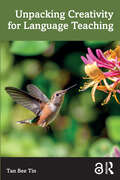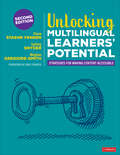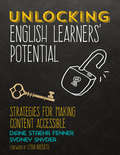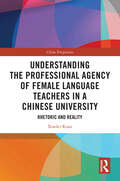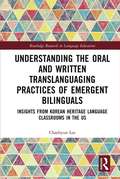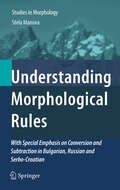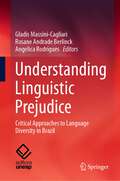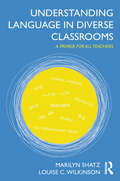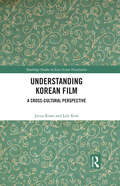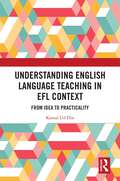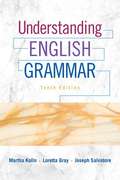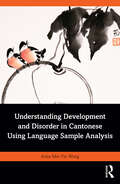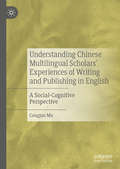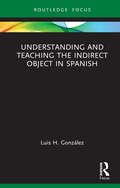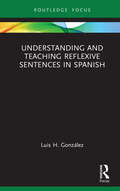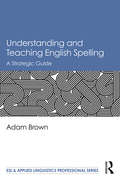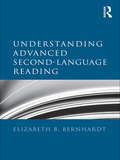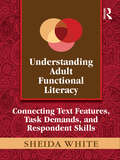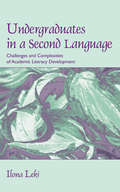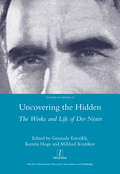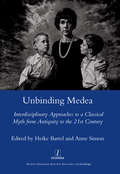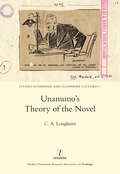- Table View
- List View
Unpacking Creativity for Language Teaching
by Tan Bee TinBefore unlocking creativity, we must first unpack what it means. In this book, creativity is unravelled from various perspectives and the relevance for language teaching and learning is explored. Tin offers a coherent discussion of creativity, adopting an inclusive and integrated but, at the same time, focused approach to creativity. Divided into 12 chapters, the book covers: A critical review of the way the term ‘creativity’ is used, defined and written about in various disciplines Various models and theories of creativity, the product- and process-oriented views of creativity and their relevance for language teaching Three pillars on which creative language pedagogy should be based Over 60 practical tasks, applying theoretical arguments and principles of creativity to language teaching and learning Based on the author’s own practice and research on creativity over the last two decades, the book provides exciting new ideas for scholars and practitioners interested in creativity and creative language pedagogy. The book serves as an important contribution for students, teachers and scholars in the field of applied linguistics, language teaching and education.
Unlocking Multilingual Learners’ Potential: Strategies for Making Content Accessible
by Diane Staehr Fenner Sydney Cail Snyder Meghan Gregoire-SmithBring classroom content to life for multilingual learners In this eagerly anticipated revision of their bestselling book, authors Diane Staehr Fenner, Sydney Snyder, and Meghan Gregoire-Smith share dynamic, research-backed strategies that every educator of multilingual learners (MLs) can add to their repertoire. Including more of what educators loved from the first edition—authentic classroom examples, a wide variety of research-based instructional strategies, and practical tools to implement across grade levels and content areas—this is the ultimate practical guide to unlocking the potential of MLs in K-12 classrooms. With fresh graphics and eye-catching colors, this thoroughly revised edition also includes: Considerations for newcomers and students with interrupted or no formal education (SLIFE) An added chapter on building scaffolded instruction and peer learning opportunities into MLs’ academic reading and writing activities Additional opportunities for reflection and application A new unit planning template aligned with research-based instructional practices, including a completed example unit Situated within five core beliefs that frame the must-haves for MLs’ equitable and excellent education, Unlocking Multilingual Learners′ Potential is a guide to research-based practices and a toolbox of strategies every educator can implement to make content accessible and increase language proficiency among MLs.
Unlocking Multilingual Learners’ Potential: Strategies for Making Content Accessible
by Diane Staehr Fenner Sydney Cail Snyder Meghan Gregoire-SmithBring classroom content to life for multilingual learners In this eagerly anticipated revision of their bestselling book, authors Diane Staehr Fenner, Sydney Snyder, and Meghan Gregoire-Smith share dynamic, research-backed strategies that every educator of multilingual learners (MLs) can add to their repertoire. Including more of what educators loved from the first edition—authentic classroom examples, a wide variety of research-based instructional strategies, and practical tools to implement across grade levels and content areas—this is the ultimate practical guide to unlocking the potential of MLs in K-12 classrooms. With fresh graphics and eye-catching colors, this thoroughly revised edition also includes: Considerations for newcomers and students with interrupted or no formal education (SLIFE) An added chapter on building scaffolded instruction and peer learning opportunities into MLs’ academic reading and writing activities Additional opportunities for reflection and application A new unit planning template aligned with research-based instructional practices, including a completed example unit Situated within five core beliefs that frame the must-haves for MLs’ equitable and excellent education, Unlocking Multilingual Learners′ Potential is a guide to research-based practices and a toolbox of strategies every educator can implement to make content accessible and increase language proficiency among MLs.
Unlocking English Learners' Potential: Strategies for Making Content Accessible
by Diane Staehr Fenner Sydney C. Snyder“Schools are not intentionally equitable places for English learners to achieve, but they could be if the right system of support were put in place. Diane Staehr Fenner and Sydney Snyder recommend just such a system. Not only does it have significant potential for providing fuller access to the core curriculum, it also provides a path for teachers to travel as they navigate the individual needs of students and support their learning journeys.” —Douglas Fisher, Coauthor of Visible Learning for Literacy A once-in-a-generation text for assisting a new generation of students Content teachers and ESOL teachers, take special note: if you’re looking for a single resource to help your English learners meet the same challenging content standards as their English-proficient peers, your search is complete. Just dip into this toolbox of strategies, examples, templates, and activities from EL authorities Diane Staehr Fenner and Sydney Snyder. The best part? Unlocking English Learners’ Potential supports teachers across all levels of experience. The question is not if English learners can succeed in today’s more rigorous classrooms, but how. Unlocking English Learners’ Potential is all about the how: How to scaffold ELs’ instruction across content and grade levels How to promote ELs’ oral language development and academic language How to help ELs analyze text through close reading and text-dependent questions How to build ELs’ background knowledge How to design and use formative assessment with ELs Along the way, you’ll build the collaboration, advocacy, and leadership skills that we all need if we’re to fully support our English learners. After all, any one of us with at least one student acquiring English is now a teacher of ELs.
Unlocking English Learners' Potential: Strategies for Making Content Accessible
by Diane Staehr Fenner Sydney C. Snyder“Schools are not intentionally equitable places for English learners to achieve, but they could be if the right system of support were put in place. Diane Staehr Fenner and Sydney Snyder recommend just such a system. Not only does it have significant potential for providing fuller access to the core curriculum, it also provides a path for teachers to travel as they navigate the individual needs of students and support their learning journeys.” —Douglas Fisher, Coauthor of Visible Learning for Literacy A once-in-a-generation text for assisting a new generation of students Content teachers and ESOL teachers, take special note: if you’re looking for a single resource to help your English learners meet the same challenging content standards as their English-proficient peers, your search is complete. Just dip into this toolbox of strategies, examples, templates, and activities from EL authorities Diane Staehr Fenner and Sydney Snyder. The best part? Unlocking English Learners’ Potential supports teachers across all levels of experience. The question is not if English learners can succeed in today’s more rigorous classrooms, but how. Unlocking English Learners’ Potential is all about the how: How to scaffold ELs’ instruction across content and grade levels How to promote ELs’ oral language development and academic language How to help ELs analyze text through close reading and text-dependent questions How to build ELs’ background knowledge How to design and use formative assessment with ELs Along the way, you’ll build the collaboration, advocacy, and leadership skills that we all need if we’re to fully support our English learners. After all, any one of us with at least one student acquiring English is now a teacher of ELs.
Understanding the Professional Agency of Female Language Teachers in a Chinese University: Rhetoric and Reality (China Perspectives)
by Xiaolei RuanCentering on a qualitative study of three female English teachers in Shanghai, China, the book explores female language teachers' perceived discrepancies and agency exercised in their teaching, research and teacher learning practices. By adopting multiple research methods, such as narrative questionnaire, metaphor, timeline, interview and classroom observation, this study reveals that female language teachers’ agency is a dynamic entity manifested in the ongoing negotiation of agency belief, agency practice, and agency inclination, as well as the interaction of individual and the environment. Though there are certain limitations concerning representativeness and generalizability, the author provides a thick description of how female language teachers in China are exercising agency to fulfill their career development, which offers insightful suggestions to language education in both China and broader areas globally. The book will appeal to researchers studying teacher education and foreign (English) language teaching, university teachers, especially female foreign language teachers, PhD students and graduate students, as well as career women.
Understanding the Oral and Written Translanguaging Practices of Emergent Bilinguals: Insights from Korean Heritage Language Classrooms in the US (Routledge Research in Language Education)
by Chaehyun LeeDetailing qualitative research undertaken with elementary-grade children in a Korean heritage language school in the US, this text provides unique insight into the translanguaging practices and preferences of young, emergent bilinguals in a minority language group. Understanding the Oral and Written Translanguaging Practices of Emergent Bilinguals examines the role of socio-cultural influences on emergent bilinguals’ language use and development. Particular attention is paid to the role of immigrant parental involvement and engagement in their bilingual children’s language learning and academic performance. Presenting data from classroom audio recordings, writing, and drawing samples, as well as semi-structured interviews with children and parents, the book identifies important implications for the education of emergent bilinguals to better support their overall language and literacy development. This text will primarily be of interest to doctoral students, researchers, and scholars with an interest in bilingual education, biliteracy, and early literacy development more broadly. Those interested in applied linguistics, the Korean language, and multicultural education will also benefit from this volume.
Understanding Morphological Rules
by Stela ManovaThis volume analyzes morphological and morphonological phenomena from a number of distinct Slavic languages. It does so in an innovative manner, yet also positions the analysis in the context of current morphological debates. It is thus a valuable contribution both to comparative Slavic morphology and general morphological theory. Moreover, the book is the first attempt at a theory of conversion and subtraction relevant to languages with rich inflectional morphology. It contributes to our structural understanding of the nature of word. As the first illustration of subtraction with examples from southern Slavic languages, it is an excellent source of specialist data. The book's theoretical framework is easily accessible and applicable to other languages, which makes it attractive to researchers on Slavic languages and general linguists alike. The volume will also appeal to general morphologists, typologists, and advanced students in linguistics.
Understanding Linguistic Prejudice: Critical Approaches to Language Diversity in Brazil
by Gladis Massini-Cagliari Rosane Andrade Berlinck Angelica RodriguesThis book discusses linguistic diversity, linguistic prejudice, and language variation and change from a Global South perspective by analyzing Brazilian Portuguese, Brazilian Sign Language (LIBRAS) and indigenous languages spoken in Brazil. It brings together studies and reflections on linguistic prejudice and social discrimination based on data and examples from Brazil and aims to bridge the gap between academic findings and popular notions related to linguistic diversity to promote language diversity and fight linguistic intolerance. Chapters in this volume present contributions to understand the origins and motivations of linguistic prejudice and foster awareness of entrenched opinions regarding linguistic diversity. The first part of the book brings together chapters analyzing basic sociolinguistic questions concerning linguistic prejudice based on theoretical discussions and qualitative research. The second part is composed of chapters that analyze linguistic prejudice in Brazil in major communities that speak Brazilian Portuguese varieties and minor communities that speak native and sign languages. Understanding Linguistic Prejudice: Critical Approaches to Language Diversity in Brazil will be a valuable resource for researchers in sociolinguistics interested in language diversity, language justice and language policy. It will also be of interest to sociologists, anthropologists and other social scientist interested in the relationship between language, diversity, equity and inclusion.
Understanding Language in Diverse Classrooms: A Primer for All Teachers
by Marilyn Shatz Louise C. WilkinsonWith the increasing linguistic and cultural diversity of students in U. S. schools, all teachers, regardless of the content area or grade they teach, need research-based strategies for assisting all students to gain English proficiency. This practical, concise guide shows teachers what they need to know about language, how it is learned, how it is used, and how teaching about it can be incorporated into lessons throughout the curriculum. Understanding Language in Diverse Classrooms offers a model of how learning takes place and describes the critical role of teachers in that model. It includes comparison charts showing how some of the most common heritage languages represented among present-day students compare with English, and it provides examples of hands-on materials including checklists, rating scales, and sample lessons to help teachers prepare to teach all their students in diverse classrooms. Each chapter ends with questions to stimulate discussion and reflection on major chapter points, to enable readers to review and evaluate the information and then integrate it into their own practice.
Understanding Korean Film: A Cross-Cultural Perspective
by Jieun Kiaer Loli KimFilm viewing presents a unique situation in which the film viewer is unwittingly placed in the role of a multimodal translator, finding themselves entirely responsible for interpreting multifaceted meanings at the mercy of their own semiotic repertoire. Yet, researchers have made little attempt, as they have for literary texts, to explain the gap in translation when it comes to multimodality. It is no wonder then that, in an era of informed consumerism, film viewers have been trying to develop their own toolboxes for the tasks that they are faced with when viewing foreign language films by sharing information online. This is particularly the case with South Korean film, which has drawn the interest of foreign viewers who want to understand these untranslatable meanings and even go as far as learning the Korean language to do so. Understanding Korean Film: A Cross-Cultural Perspective breaks this long-awaited ground by explaining the meaning potential of a selection of common Korean verbal and non-verbal expressions in a range of contexts in South Korean film that are often untranslatable for English-speaking Western viewers. Through the selection of expressions provided in the text, readers become familiar with a system that can be extended more generally to understanding expressions in South Korean films. Formal analyses are presented in the form of in-depth discursive deconstructions of verbal and non-verbal expressions within the context of South Korea’s Confucian traditions. Our case studies thus illustrate, in a more systematic way, how various meaning potentials can be inferred in particular narrative contexts.
Understanding Korean Film: A Cross-Cultural Perspective (Routledge Studies in East Asian Translation)
by Jieun Kiaer Loli KimFilm viewing presents a unique situation in which the film viewer is unwittingly placed in the role of a multimodal translator, finding themselves entirely responsible for interpreting multifaceted meanings at the mercy of their own semiotic repertoire. Yet, researchers have made little attempt, as they have for literary texts, to explain the gap in translation when it comes to multimodality. It is no wonder then that, in an era of informed consumerism, film viewers have been trying to develop their own toolboxes for the tasks that they are faced with when viewing foreign language films by sharing information online. This is particularly the case with South Korean film, which has drawn the interest of foreign viewers who want to understand these untranslatable meanings and even go as far as learning the Korean language to do so. Understanding Korean Film: A Cross-Cultural Perspective breaks this long-awaited ground by explaining the meaning potential of a selection of common Korean verbal and non-verbal expressions in a range of contexts in South Korean film that are often untranslatable for English-speaking Western viewers. Through the selection of expressions provided in the text, readers become familiar with a system that can be extended more generally to understanding expressions in South Korean films. Formal analyses are presented in the form of in-depth discursive deconstructions of verbal and non-verbal expressions within the context of South Korea’s Confucian traditions. Our case studies thus illustrate, in a more systematic way, how various meaning potentials can be inferred in particular narrative contexts.
Understanding English Language Teaching in EFL Context: From Idea to Practicality
by Kamal Ud DinThis volume is comprehensively designed to help prospective English Language Teaching (EFL) teachers specializing in EFL mainly in South Asian countries. It analyses the application of ELT theories, concepts, and methods to sharpen their understanding of the various techniques used for teaching English effectively in the EFL context. The book discusses the basic concepts of language aimed to develop a sense of the language phenomenon as a unique human attribute. It covers the theories of language from various disciplines such as biology, sociology, psychology, and linguistics. The book explains the underlying structures or components that shape the edifice of languages such as phonology, morphology, syntax, grammar, phonetics, semantics, and pragmatics. While taking the reader through language learning theories with a focus on English as the second language, it discusses the different teaching methods that can be adopted by teachers in classroom settings. The book will be of interest to teachers, students and researchers of education, teacher education, and English Language Teaching. It will also be useful for educators, English language teachers, language learners, professionals working in the field of education and language, and those who aspire to teach and learn English in Foreign context.
Understanding English Grammar: Tenth Edition
by Martha J. Kolln Robert W. Funk Loretta Gray Joseph SalvatoreThe essentials of English grammar, with a distinctively clear organization and user-friendly language. The acclaimed Understanding English Grammar fosters students’ innate language expertise as they study sentence grammar. It offers a practical blend of the most useful elements of both traditional and new linguistic grammar, beginning with an overview of English as a world language, language change, and various classroom issues associated with prescriptive grammar and correctness, along with an updated list of further readings. Every discussion is viewed through the eyes of a novice reader, bearing in mind how the current generation of students uses communication tools for social purposes. Both students and teachers appreciate the self-teaching quality that incremental exercises provide throughout the chapters, with answers at the end of the book. The Tenth Edition introduces new coauthors Loretta Gray and Joseph Salvatore—two respected scholars who bring their special expertise in linguistics and creative writing, as well as long experience in teaching grammar and writing.
Understanding Development and Disorder in Cantonese using Language Sample Analysis
by Anita Mei-Yin WongUnderstanding Development and Disorder in Cantonese using Language Sample Analysis brings together 20 years of research on typical development and Development Language Disorder (DLD) in Cantonese. This book begins with a succinct overview of Cantonese, which is a popular variety of Chinese, a Sino-Tibetan language. The second chapter describes a new framework of the Grammatical Analysis of Cantonese Samples (GACS), which is developed on the basis of functionalist and usage-based theories of language and language development. The third chapter reports on a quantitative analysis, as well as a qualitative description of the development of Cantonese in preschool children using the GACS framework. The book ends with a chapter that presents the linguistic profile of a Cantonese-speaking child with DLD. It also illustrates how to make decisions on intervention targets on the basis of the grammatical and error analysis. The book provides a timely and important addition to the typological diversity of studies in both child language development and disorder. This book is informative for students and practitioners of speech and language therapy, students in early childhood education and Chinese linguistics, and researchers in child language development and disorders.
Understanding Chinese Multilingual Scholars’ Experiences of Writing and Publishing in English: A Social-Cognitive Perspective
by Congjun MuThis book analyses the English writing and publishing experiences of 118 scholars from 18 Chinese universities from a social-cognitive perspective. It addresses the challenges and strategies multilingual scholars, particularly Chinese academics, reported in the process of writing and publishing in English. This allows the author to present a taxonomy of journal article writing strategies that correspond to the lived experiences of scholars in China, but which can also be applied to other contexts in the world. This book offers a step-by-step analysis of ethnographic case studies, insights and implications for teaching practice, as well as suggested directions for future research. It will be of particular interest to scholars in the fields of ERPP (English for Research Publication Purposes) as well as students and scholars of applied linguistics more broadly.
Understanding and Teaching the Indirect Object in Spanish (Verber, Verbed Grammar)
by Luis H. GonzálezUnderstanding and Teaching the Indirect Object in Spanish presents an easy-to-understand approach to all aspects of direct and indirect objects in Spanish. Distinguishing between direct and indirect objects can pose challenges for learners and is almost impossible to do using the tools that linguists have traditionally used. This book offers two simple, all-encompassing inferences that allow learners to tackle this area of language by intuitively inferring the distinction, as native speakers do, between verber and verbed. This book will be of interest to teachers and learners of Spanish and other second languages, as well as linguists interested in argument structure, second language acquisition, second language teaching or pedagogy, and multilingualism.
Understanding and Teaching Reflexive Sentences in Spanish
by Luis H. GonzálezUnderstanding and Teaching Reflexive Sentences in Spanish provides a fresh, simple, and novel approach to understanding and teaching the use of the intransitivizing se. Understanding reflexive sentences can be challenging for learners of Spanish. Instead of expecting learners to memorize multiple rules, the author offers one simple rule that allows learners to intuitively understand and use reflexive sentences. Sample exercises for students at all levels of language proficiency are also provided to practice and internalize the new approach. This book will be of interest to teachers and learners of any second language, as well as linguists interested in second language acquisition or in second language teaching or pedagogy.
Understanding and Teaching English Spelling: A Strategic Guide (ESL & Applied Linguistics Professional Series)
by Adam BrownConcise and engaging, this text provides pre-service and practicing English language teachers with the knowledge they need to successfully teach the spelling of English. Offering context and explanation for the English spelling system as well as uniquely addressing specific problems in learning the spelling of English words, this book empowers readers with strategies for coping with these problems. Divided into six accessible sections, Brown covers the history of English spelling, the influence of technology on spelling, the role of punctuation, the features of present-day English spelling, teaching strategies for coping with difficult spelling, and the future of spelling and literacy. The short, digestible chapters include practical learning objectives and end-of-chapter exercises to help teachers understand and explain English spelling concepts.
Understanding Advanced Second-Language Reading
by Elizabeth B. BernhardtWhat distinguishes this book is its broad, yet thorough, view of theory, process, and research on adult second-language reading. Offering extensive discussions of upper-register second-language texts (both expository and narrative) that adult second-language readers encounter daily across the globe, it also presents an assessment schema for second-language text comprehension as well as for the assessment of teaching. Understanding Advanced Second-Language Reading: includes languages other than English in the discussion of second language reading is firmly anchored in a theory of second language reading ─ the concept of compensatory processing emphasizes the multi-dimensionality and dynamic nature of L2 reading development focuses on comprehension of upper-register literary texts balances theory and instructional practices. Filling the need for a coherent, theoretically consistent, and research-based portrait of how literate adolescents and adults comprehend, and learn to comprehend, at greater levels of sophistication and whether that ability can be enhanced by instruction, this is a must-have resource for reading and second-language researchers, students, and teachers.
Understanding Adult Functional Literacy: Connecting Text Features, Task Demands, and Respondent Skills
by Sheida White"This is a genuinely scholarly work ... It is based on [analysis of] the most up-to-date quantitative surveys that we have on adult literacy. These surveys are the gold standard in terms of documenting adult literacy in the United States ...The author analyzes these extensive surveys and puts them into a theoretical context in a way that has not been done before." – Rosemary J. Park, University of Minnesota "I don’t know of any book providing the same information. There is a shortage of literature in this area and the book is an excellent contribution." – Dolores Perin, Teachers College, Columbia University "The contribution of the theory is important – not only to adult literacy but to our understanding of the reading process at nearly every level ... Additionally, the application of multidimensional item response modeling to the new TTR theory offers a tantalizing view of how the predictive validity of a theory might be tested and used to provide practical results." – Larry Mikulecky, Indiana University Very often, individual differences in literacy performance are understood exclusively in terms of the characteristics of the reader. Drawing on a rich array of empirical research, the author presents a detailed and highly integrative new theory of functional literacy. The text-task-respondent (TTR) theory of functional literacy offers improved understanding of how successful performance on everyday literacy tasks involves a dynamic relationship among the text, the task, and the reader. This book will appeal primarily to assessment developers who wish to select tasks and texts of varying difficulty to yield more precise estimates of adult literacy; to researchers who study cognitive, linguistic, and discourse processes; and to teachers who want to find new ways to increase text comprehension among students, including English language learners and struggling readers. The text is appropriate for an advanced course in adult education, discourse analysis, educational measurement, educational psychology, literacy, or linguistics – or as a reference work for those interested in literacy.
Undergraduates in a Second Language: Challenges and Complexities of Academic Literacy Development
by Ilona LekiThis is the first book-length study of bilingual, international, and immigrant students in English writing courses that attempts to fully embed their writing experiences within the broader frame of their personal histories, the human context of their development, and the disciplinary contexts of their majors. It addresses the questions: How useful are L2 writing courses for the students who are required to take them? What do the students carry with them from these courses to their other disciplinary courses across the curriculum? What happens to these students after they leave ESL, English, or writing classes? Drawing on data from a 5-year longitudinal study of four university students for whom English was not their strongest/primary language, it captures their literacy experiences throughout their undergraduate careers. The intensive case studies answer some questions and raise others about these students’ academic development as it entwined with their social experiences and identity formation and with the ideological context of studying at a US university in the 1990s.
Uncovering the Hidden: The Works and Life of Der Nister
by Gennady EstraikhDer Nister (Pinkhes Kahanovitsh, 1884-1950) is widely regarded as the most enigmatic author in modern Yiddish literature. His pseudonym, which translates as 'The Hidden One', is as puzzling as his diverse body of works, which range from mystical symbolist poetry and dark expressionist tales to realist historical epic. Although part of the Kiev Group of Yiddish writers, which also included David Bergelson and Peretz Markish, Der Nister remained at the margins of the Yiddish literary world throughout his life, mainstream success eluding him both in- and outside the Soviet Union. Yet, to judge from the quantity of recent research and translation work, der Nister is today one of the best remembered Yiddish modernists. The present collection of twelve original articles by international scholars re-examines Der Nister's cultural and literary legacy, bringing to light new aspects of his life and creative output.
Unbinding Medea
by Heike BartelMedea - simply to mention her name conjures up echoes and cross-connections from Antiquity to the present. The vengeful wife, the murderess of her own children, the frail, suicidal heroine, the archetypal Bad Mother, the smitten maiden, the barbarian, the sorceress, the abused victim, the case study for a pathology. For more than two thousand years, she has arrested the eye in paintings, reverberated in opera, called to us from the stage. She demands the most interdisciplinary of study, from ancient art to contemporary law and medicine; she is no more to be bound by any single field of study than by any single take on her character. The contributors to this wide-ranging volume are Brian Arkins, Angela J. Burns, Anthony Bushell, Richard Buxton, Peter A. Campbell, Margherita Carucci, Daniela Cavallaro, Robert Cowan, Hilary Emmett, Edith Hall, Laurence D. Hurst, Ekaterini Kepetzis, Ivar Kvistad, Catherine Leglu, Yixu Lue, Edward Phillips, Elizabeth Prettejohn, Paula Straile-Costa, John Thorburn, Isabelle Torrance, Terence Stephenson, and Amy Wygant.
Unamuno's Theory of the Novel
by C.A. LonghurstMiguel de Unamuno (1864-1936) is widely regarded as Spain's greatest and most controversial writer of the first half of the twentieth century. Professor of Greek, and later Rector, at the University of Salamanca, and a figure with a noted public profile in his day, he wrote a large number of philosophical, political and philological essays, as well as poems, plays and short stories, but it is his highly idiosyncratic novels, for which he coined the word nivola, that have attracted the greatest critical attention. Niebla (Mist, 1914) has become one of the most studied works of Spanish literature, such is the enduring fascination which it has provoked. In this study, C. A. Longhurst, a distinguished Unamuno scholar, sets out to show that behind Unamuno's fictional experiments there lies a coherent and quasi-philosophical concept of the novelesque genre and indeed of writing itself. Ideas about freedom, identity, finality, mutuality and community are closely intertwined with ideas on writing and reading and give rise to a new and highly personal way of conceiving fiction.
